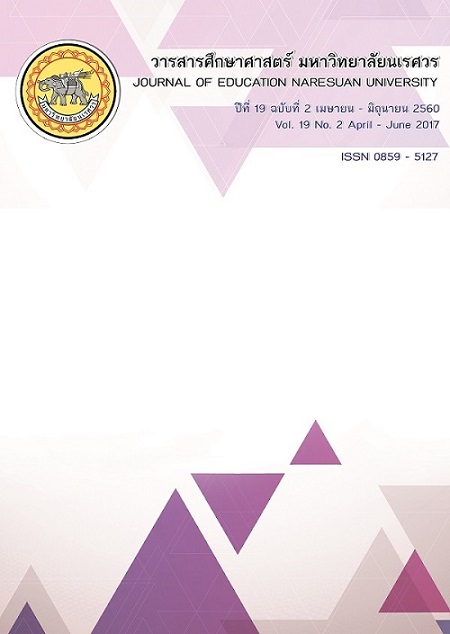รูปแบบการจัดการเรียนรู้เพื่อพัฒนาความสามารถด้านการคิดเชิงวิเคราะห์ สำหรับนักศึกษาครูมหาวิทยาลัยราชภัฏ ตามแนวคิดปริสีมาที่สาม
Main Article Content
Abstract
การวิจัยครั้งนี้มีวัตถุประสงค์เพื่อ 1) พัฒนารูปแบบการจัดการเรียนรู้เพื่อส่งเสริมความสามารถด้านการคิดเชิงวิเคราะห์สำหรับนักศึกษาครู ตามแนวคิดปริสีมาที่สาม 2) ประเมินความสามารถด้านการคิดเชิงวิเคราะห์ของนักศึกษาครูหลังใช้รูปแบบการจัดการเรียนรู้ที่พัฒนาขึ้น และ 3) ประเมินความคิดเห็นและความพึงพอใจของนักศึกษาครูที่มีต่อรูปแบบการจัดการเรียนรู้ที่พัฒนาขึ้น กลุ่มตัวอย่างในการวิจัยได้แก่ นักศึกษาครูสาขาวิชาสังคมศึกษาชั้นปีที่ 3 จำนวน 2 กลุ่มเรียน และชั้นปีที่ 4 จำนวน 1 กลุ่มเรียน มีจำนวนนักศึกษา 37, 47 และ 33 คน ตามลำดับ การดำเนินการวิจัยแบ่งเป็น 4 ระยะ ได้แก่ ระยะที่ 1 การวิจัยเอกสารและวิจัยภาคสนาม (R1) ระยะที่ 2 การพัฒนาร่างรูปแบบการจัดการเรียนรู้เพื่อพัฒนาความสามารถด้านการคิดเชิงวิเคราะห์สำหรับนักศึกษาครู (D1) ระยะที่ 3 การศึกษาการนำร่างรูปแบบการจัดการเรียนรู้เพื่อพัฒนาความสามารถด้านการคิดเชิงวิเคราะห์ไปทดลองใช้ โดยใช้ Mixed Technique กับนักศึกษาครูชั้นปีที่ 3 กลุ่มที่หนึ่ง และ ใช้ Mini-Lecture, T-P-S /KWL และนำเสนอผลงาน กับนักศึกษาครูชั้นปีที่ 4 และชั้นปีที่ 3 กุล่มที่สอง (R2) และระยะที่ 4 การพัฒนารูปแบบการจัดการเรียนรู้เพื่อพัฒนาความสามารถด้านการคิดเชิงวิเคราะห์สำหรับนักศึกษาครูที่สมบูรณ์ (D2) เครื่องมือที่ใช้ในการวิจัย ได้แก่ 1) รูปแบบการจัดการเรียนรู้ที่พัฒนาความสามารถด้านการคิดเชิงวิเคราะห์ 2) แบบประเมินความสามารถด้านการคิดเชิงวิเคราะห์ และ 3) แบบสอบถามความคิดเห็นและความพึงพอใจ สถิติที่ใช้ในการวิจัยได้แก่ ค่าความถี่ ค่าร้อยละ ค่าเฉลี่ย ส่วนเบี่ยงเบนมาตรฐาน และการทดสอบ ANOVA ผลการวิจัย พบว่า 1) รูปแบบการจัดการเรียนรู้เพื่อส่งเสริมความสามารถด้านการคิดเชิงวิเคราะห์ของนักศึกษาครู ประกอบด้วย รูปแบบการสอนแบบ Team-Based Learning และผังกราฟิก รูปแบบการสอนแบบ Mini-Lecture, KWL, T-P-S และการเสนอผลงาน รูปแบบการสอนแบบปัญหาเป็นฐานและคำถามตามแนวโสเครติส รูปแบบการสอนแบบ Peer Feedback และคำถามตามแนวโสเครติส รูปแบบการสอนแบบ Six thinking hats และผังการโต้แย้ง และรูปแบบการสอนแบบ Case-Based Learning, การอภิปรายและการระดมสมองซึ่งมีความเที่ยงตรงเชิงเนื้อหา CVI= .8-1.0 2) ความสามารถด้านการคิดเชิงวิเคราะห์ของนักศึกษาครูสาขาวิชาสังคมศึกษา หลังใช้รูปแบบการจัดการเรียนรู้ที่พัฒนาขึ้น พบว่ามีจำนวนนักศึกษาคิดเป็นร้อยละ 82 ของนักศึกษาครูที่เป็นกลุ่มตัวอย่างทั้งหมด
มีความสามารถด้านการคิดเชิงวิเคราะห์สูงกว่าเกณฑ์ร้อยละ 70 นอกจากนี้ ผลการเปรียบเทียบความสามารถด้านการคิดเชิงวิเคราะห์ของนักศึกษาครู เมื่อใช้รูปแบบการจัดการเรียนรู้ 2 ลักษณะกับนักศึกษาครูจำนวน 3 กลุ่มตามที่กล่าวข้างต้น พบว่า ไม่มีความแตกต่างในชั้นปีเดียวกัน แต่มีความแตกต่างกันในระหว่างชั้นปี และ 3) นักศึกษาครูมีความคิดเห็นและความพึงพอใจทางบวกต่อกิจกรรมการเรียนรู้ที่พัฒนาขึ้น กล่าวคือ นักศึกษาชอบและมีความรู้สึกที่ดีในกิจกรรมการเรียนรู้ที่ใช้วิธีการและเทคนิคการสอนที่หลากหลาย ทำให้สนใจในการเรียนได้ยาวนานและเกิดการเรียนรู้ได้ด้วยดี จากการวิจัยในครั้งนี้สะท้อนให้เห็นว่ารูปแบบการจัดการเรียนรู้ที่พัฒนาขึ้นสามารถนำไปใช้ในการส่งเสริมความสามารถด้านการคิดเชิงวิเคราะห์ให้กับนักศึกษาครูได้ และยังเป็นส่วนสำคัญในการยกระดับความเป็นครูมืออาชีพและเส้นทางอาชีพให้กับนักศึกษาครูได้อย่างมีประสิทธิภาพต่อไป
A MODEL BASED ON THE THIRD SPACE CONCEPT TO ACHIEVE ABILITY IN CRITICAL THINKING OF PRE-SERVICE TEACHERS IN RAJABHAT UNIVERSITY
This research study aimed 1) to develop an instructional model for enhancing the pre-service teachers’ critical thinking ability based on the third space concept, 2) to evaluate the pre-service teachers’ critical thinking ability after using the constructed instructional model, and 3) to evaluate the pre-service teachers’ satisfaction and opinions towards the implemented model. The sampling groups of this study were 3 sections of the pre-service teachers majoring in social study: 37 third year participants in section 1, 47 third year participants in section 2, and 33 fourth year participants. The development methodology was conducted through 4 phases: conducting documentary research and field research (Phase 1: R1), developing the prototype of the instructional model for enhancing the pre-service teachers’ critical thinking ability (Phase 2: D1), collecting data from the constructed model’s prototype testing in which the section 1 participants, third year, were taught by the Mixed Technique and the fourth year and the third year participants, section 2, were taught by Mini-Lecture, T-P-S/KWL and assigned to do their presentation (Phase 3: R2), the refinement and rectification on the constructed model (Phase 4: D2). The research instruments were 1) the instructional model for enhancing the critical thinking ability, 2) the critical thinking ability evaluation form, and 3) the opinion and satisfaction survey questionnaire. The statistical treatment of this study was frequency, percentage, mean scores, deviation and ANOVA. The result revealed that: 1) the instructional model for enhancing the pre-service teachers’ critical thinking ability consisted of the team-based learning model with graphic organizers, the mixed model of Mini-Lecture, KWL, T-P-S with presentation assignments, the problem-based learning model with Socratic method, the peer feedback model with Socratic method, the six thinking hat model with argumentative idea maps and the case-based learning model with discussion and brain storming. The content validity of these elements was .8 - 1.0, 2) 82 percent of the participants possessed better critical thinking ability which was above the 70 percent attainment target. Moreover, the comparison results of the critical thinking ability development after using the 3 mentioned models showed that there was no difference between those 2 third year sections but the learning achievement between the fourth and the third year participants was found different, and 3) the participants’ opinions and satisfaction towards the model were positive. They were satisfied with a variety of activities and teaching techniques which longer roused their interest and helped better their learning. This study reflected that the instructional model was a good contribution to develop critical thinking and was able to empower the professional teacher quality leverage and progress in their profession.
Article Details
The owner of the article does not copy or violate any of its copyright. If any copyright infringement occurs or prosecution, in any case, the Editorial Board is not involved in all the rights to the owner of the article to be performed.


